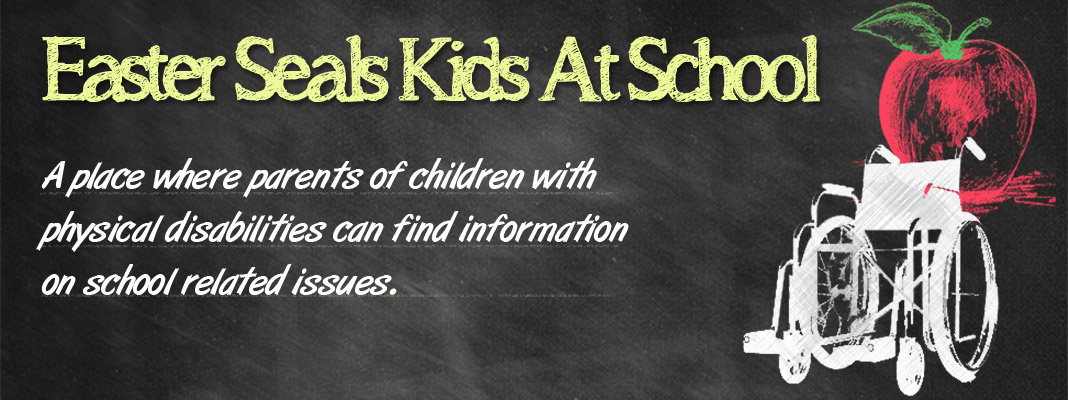September is the start of a new school year and we are all excited to have a fresh start. This usually includes a new lunch bag, backpack, crayons and paper and a new teacher. A fresh start creates the opportunity for new relationships and approaches to learning. It is also important that the strategies that have supported success in the past are in place for students with special needs.
Ideally, a transition plan was developed at the end of the last school year and supports are in place from day one. This means that accessibility needs have been addressed and special equipment, personal care and health supports are available for the student. If there is a problem, look at the transition plan and identify who was responsible. Contact the classroom teacher, or the Principal, and find out when the situation will be resolved.
The Individual Education Plan (IEP) is the key document that supports success in the classroom. The IEP lists the accommodations, teaching and assessment strategies that are helpful for the student. Arrange a meeting with the teacher and bring the IEP from last year to the meeting. Highlight the supports that will help your child settle quickly into the new classroom. Find out what will be available immediately and what still needs to be arranged.
You can share some of the responsibility with your child. Most students can report on what is happening in the classroom and if they are getting the same supports and services as last year. Many secondary school students can take responsibility for meeting with the teacher and reviewing the IEP.
School Principals are required to review or develop an IEP within 30 school days of the start of the new grade. The principal can delegate the IEP review process to the special education or classroom teacher who should contact you and invite your input into the IEP. There are different ways of getting your input and the teacher may share a copy of the last IEP or a draft of the new IEP, invite you to a meeting or talk over the phone. These are all good ways to collect your input.
You can provide input by providing information on the following topics:
- Successes from the last school year
- Information on equipment or personal care needs of your child
- Recent changes in your child’s health or behaviour
- Details of any community support programs or therapists involved with your child
- Concerns you have about your child’s academic or social skills
Look at the IEP from last year and ask yourself the following questions:
- Was my child’s program accommodated (AC), modified (MOD) or an alternative program (ALT)?
- If your child required accommodations (either environmental, instructional, or for assessment):
- Has your child been getting all of the accommodations in the classroom?
- Did the accommodations helping the student to be successful?
- If the student’s program was modified from the grade level:
- What were the Learning Expectations for the last term?
- Did your child achieve all or part of these expectations?
- What were the Teaching Strategies the Teacher used last year?
- Were the teaching methods helpful?
- What were the Assessment Methods that were used?
- Were the Assessment Methods helpful in showing the student’s progress?
- If the student was on an Alternative Program:
- What was the Annual Goal for the program?
- Did your child achieve the Learning Expectations for the last term?
- Were the teaching strategies and assessment methods helpful
- If there was a transition plan for the change of grade or school, was it put in place?
- Was the transition plan and strategies helpful?
- Are there any additional strategies that might help future transitions?
- Looking at the transition plan to the end of high school:
- Are the long term goals for after high school appropriate?
- What actions have been completed and what new actions are required this term?
- Is the log of Parent/Student Consultation accurate and does it reflect your most recent input?
- Have you returned the Parent Consultation form to confirm that you have reviewed the draft IEP and provide additional feedback?
When you are providing input to the IEP for the new term, or reviewing the draft IEP, make sure that the strategies and supports that have helped your child in the past, or have been proposed for the new term are included.
When the new IEP is sent home, typically around Thanksgiving, review it carefully to make sure that your input has been included. Over the next few months monitor whether the accommodations and supports are in place, and your child’s progress. If you child is exceeding the program goals, or having difficulty meeting learning expectations, request a meeting or make sure the IEP is changed at the next IEP review.
Children vary in their ability to adjust to change and it can take time for your child to settle in the new class. If you are concerned that your child is too anxious or unhappy after 6 or 8 weeks ask for a meeting to find out whether the teacher has the same concerns. Together you can try to figure out the problem and make any necessary changes.
For more information on Individual Education Plans check out the Ministry of Education, Individual Education Plan A Resource Guide (2004) available at:
http://www.edu.gov.on.ca/eng/general/elemsec/speced/guide/resource/index.html
